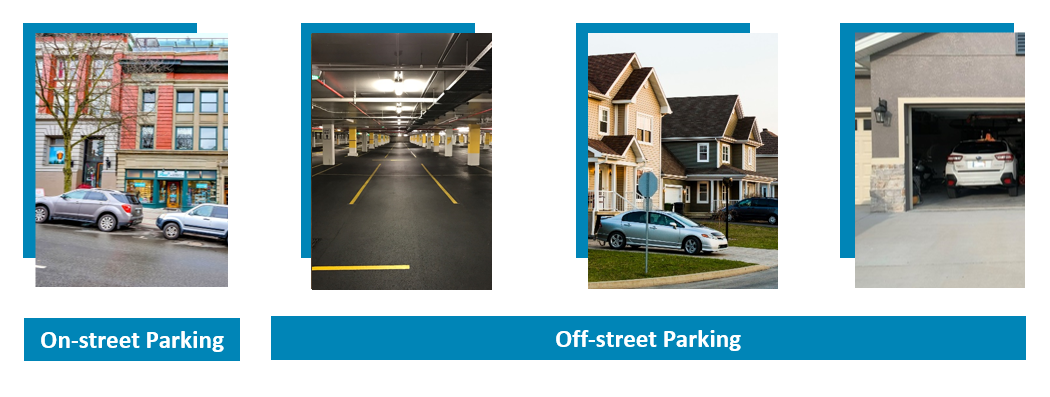For the purposes of this project, curb access and management of curb space refers to various policies, programs, infrastructure, and operating changes that result in more equitable and beneficial use of our curb space (the portion of the right-of-way adjacent to travel lanes that is directly beside the curb, often used for parking).

Figure: 1 Components of City right-of-way
Today in the City of North Vancouver, over 90% of the City’s curb space is dedicated to vehicle parking. This leaves less room for a growing number of other uses, including transit stops, micromobility parking, places for people and goods to be dropped off and picked up, and places for people to enjoy parklets and patios.
There may also be a need for dedicated room for various road users to travel in the curb lane, including transit, active, and electric modes, including bikes, scooters, and vehicles. Tailoring our street design and curb space allocation to prioritize a range of functions will create a more complete mobility network that improves equity, access, and sustainability.
The goal is to better manage car parking – not necessarily reduce it – while also enabling different uses of the curb in alignment with the goals and objectives of our Council-approved Mobility Strategy.
What is ‘on-street’ and ‘off-street’ parking?
While the main focus of this work will be on the curb lane, some of the access considerations also relate to off-street areas adjacent to the curb.
Off-street space adjacent to the curb lane can also be better managed to support the development of our public realm (places for people), green infrastructure elements such as space for trees, storm water management, greenspace, and infrastructure required to support lighting, electric charging, and telecommunications.

There are a number of parking restrictions that the City currently deploys to manage parking.

- Unrestricted parking: For a large amount of the City, particularly in residential neighbourhoods outside of the regional City Centre, we generally have unrestricted parking (no signage, first come first serve).
- Permit restrictions: In areas adjacent to our commercial main streets such as Lonsdale, we have several areas with resident permit parking. The intention here is reduce external parking pressure on residential streets outside commercial areas and help residents with insufficient off-street parking.
- Time or vehicle-type restrictions: We also have time-limited and vehicle type restrictions. This is particularly the case in our busiest areas (for example in Lower Lonsdale). Time-based restrictions encourage higher turnover so more people are able to find parking near businesses. Examples of vehicle-type restrictions would be a loading zones for picking up people, or dropping off goods; or an accessible parking space for someone with a SPARC accessible parking placard.
- Paid parking: The City has a limited number of on-street paid parking spaces around the Lions Gate Hospital, which promote higher turnover by creating a cost to use the space for a limited amount of time. The cost associated with paid parking can be altered over time to manage demand and turnover on our streets.
The first step of the plan development is to gather input from the community to understand what is working well on our curbs, and what needs to be reassessed. This will include engaging with the public, businesses, community groups, and more. We know there are many areas that need rethinking, and we want to hear about your experience.
After the first phase of engagement, staff will develop policy directions and work with the community in the spring of 2024 to refine the plan. Staff will bring the final plan to Council next summer.
It’s important to note that no decisions have been made, and that if Council directs staff to make any changes to curb regulations, that implementation will be phased.
Phase 1 – Building Awareness & Input | Winter 2023 | Currently Underway
We’re currently in Phase 1!
Building awareness of the project and providing opportunities for the public to participate and share their needs.
Phase 2 – Develop Preliminary Directions | Spring 2024
Develop Preliminary Directions for the Curb Access & Parking Plan and share feedback received during previous phase of engagement.
Phase 3 – Community Engagement | Summer 2024
Present Preliminary Directions for the Curb Access & Parking Plan for review and feedback from interested parties.
Phase 4 – Finalize the Plan | Fall 2024
Refine the Plan based on feedback, and present the finalized Plan to Council for endorsement.
Phase 4 – Implementation | Winter 2024 onwards
Communicate the final Plan to the public and begin implementation across the City of North Vancouver.